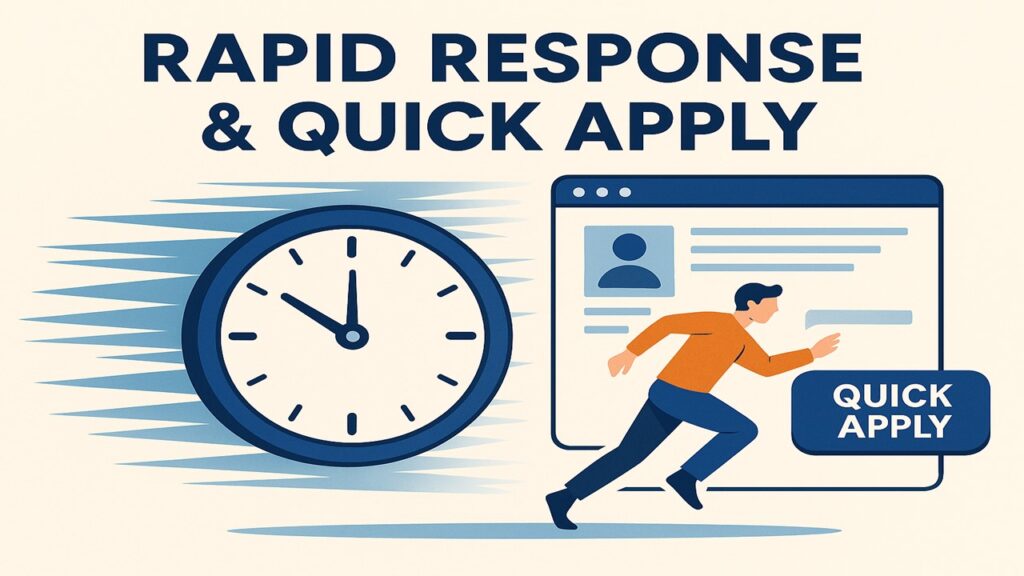🙋♂️ 1. Availability of self – 24/7
🔹 What It Means:
When I say I am available 24/7, it means I am always ready to assist, respond, or act—anytime, any day, with commitment and responsibility.
🔸 Core Values Behind My 24/7 Availability:
🕒 Responsiveness:
I respond quickly, whether it’s early morning or late night.📞 Support Anytime:
Available for calls, messages, emails, or tasks at any hour.🔄 Consistency:
My presence isn’t limited to working hours—it’s round the clock, especially in urgent situations.🤝 Reliability:
You can count on me in emergencies, deadlines, or unexpected challenges.
🔸 Why I Offer 24/7 Availability:
✅ To ensure no delay in decision-making or support.
💼 To provide uninterrupted workflow and guidance to teams or clients.
🔍 To show dedication, professionalism, and ownership of responsibilities.
🔸 Situations Where I’m 24/7 Available:
| Situation | My Role |
|---|---|
| Urgent Work Issues | Immediate resolution or support |
| Team Member Needs Help | Available for advice & direction |
| Client Inquiries | Quick and clear response |
| Emergencies or Downtime | On alert to act fast |
✨ In Summary:
“I don’t clock out—I stay connected. Because real responsibility doesn’t wear a watch.”
My 24/7 availability isn’t just a phrase—it’s a personal promise of presence, trust, and support.
Understanding Self-Availability
Self-availability refers to the readiness and willingness of an individual to be present and responsive, not only in a physical sense but also in emotional, mental, and spiritual dimensions. This concept transcends the traditional understanding of availability, which often emphasizes mere physical presence. It encompasses a holistic approach where one is attuned to their own needs and those of others, fostering deeper connections and effective communication. In today’s fast-paced world, the importance of being available, in all aspects of life, becomes increasingly crucial.
In a personal context, self-availability allows individuals to cultivate meaningful relationships. When one is present emotionally and mentally, it enhances the ability to understand and empathize with others. This connection fosters trust and respect, crucial elements for any healthy relationship. Furthermore, being available to oneself means recognizing personal needs, allowing for self-care and reflection. By maintaining a constant state of self-availability, individuals are better equipped to handle life’s challenges and foster personal growth.
In a professional setting, self-availability is equally significant. When employees demonstrate readiness to engage with colleagues and clients, it creates an atmosphere of collaboration and support. This mindset encourages open communication, reducing misunderstandings and fostering teamwork. Additionally, leaders who exemplify self-availability can inspire their teams, highlighting the importance of being attentive and responsive to the needs of others. This approach cultivates a positive workplace culture, enhancing productivity and employee satisfaction.
The benefits of embracing self-availability are manifold. Individuals who prioritize being available—emotionally, mentally, and spiritually—experience improved well-being and stronger relationships. By recognizing the multifaceted nature of availability, one can cultivate a mindset that promotes resilience and support, ultimately leading to a more fulfilling personal and professional life.
The Role of Self-Awareness in Availability
Self-awareness serves as a foundational element in the concept of self-availability. Understanding one’s own needs, emotions, and boundaries is essential for establishing the ability to be available for oneself and subsequently for others. Without a clear insight into personal states, individuals may find it challenging to manage their time and energy effectively, leading to potential burnout or emotional fatigue.
One of the most effective methods to enhance self-awareness is through mindfulness practices. Mindfulness encourages individuals to engage in present-moment awareness, allowing them to better recognize their thoughts and feelings as they arise. This practice not only fosters a deeper connection to oneself but also paves the way for improved emotional regulation. Regular mindfulness exercises, such as meditation or deep breathing, can help individuals cultivate a more profound understanding of their emotional landscape. As a result, they can discern when they are genuinely available to assist others or when they must prioritize self-care.
In addition to mindfulness, reflective journaling can serve as a powerful tool for increasing self-awareness. By documenting thoughts and feelings, individuals can identify patterns in their behavior, recognize their triggers, and better comprehend their emotional responses. This practice facilitates a dialogue with oneself, allowing for deeper insights into what it means to be available. Journaling creates a safe space to explore vulnerabilities and reinforces the importance of setting boundaries, which ultimately enhances one’s capacity to be present for others.
Establishing a regular routine that includes mindfulness and reflective journaling encourages continual growth in self-awareness. The more in tune individuals become with their inner workings, the better equipped they are to be available, not only for their own well-being but also for those around them. This dual focus is what makes self-awareness a critical component of self-availability.
Setting Boundaries for Healthy Availability
In an era defined by constant connectivity, the concept of self-availability has gained significant attention. However, being available 24/7 does not necessitate relinquishing personal time or well-being. Establishing clear boundaries is essential for maintaining a healthy balance between individual availability and personal needs. By implementing effective strategies, individuals can navigate their availability without feeling overwhelmed or drained.
First and foremost, understanding one’s limits is crucial. Each person’s capacity for availability differs, and recognizing when to say no is a vital skill. This involves taking an honest assessment of personal commitments and determining what can realistically be accommodated. Setting realistic expectations for oneself and others fosters a more manageable schedule, allowing for important individual time and self-care.
Time-blocking is a practical approach to establish boundaries. This technique involves allocating specific times during the day for work, personal projects, and downtime. By scheduling periods dedicated to self-care or relaxation, individuals can reduce the likelihood of encroachment on personal time, ensuring that they recharge effectively. Furthermore, sharing these boundaries with colleagues and family members can create an understanding environment in which respect for personal time is upheld.
In addition, utilizing technology wisely plays a significant role in managing availability. For instance, employing tools such as “do not disturb” features and setting clear response times for emails and messages can help maintain boundaries. This allows individuals to be available without being overwhelmed by constant notifications and demands. It is also essential to communicate these boundaries openly and assertively, thus promoting a culture of mutual respect regarding personal availability.
Overall, establishing healthy boundaries promotes a sustainable approach to self-availability. By prioritizing one’s well-being and employing effective strategies, individuals can enjoy being available while still safeguarding their personal time and self-care. This balance is key to achieving a fulfilling and productive lifestyle.
The Benefits of 24/7 Self-Availability
Embracing a 24/7 self-availability mindset can yield numerous benefits across various aspects of life. One of the most profound advantages is the enhancement of personal and professional relationships. When an individual maintains availability, they foster a sense of trust and reliability among their peers and loved ones. This approach ensures that individuals can be there for others in times of need, which strengthens bonds and promotes a supportive environment. For instance, a manager who adopts this mindset can provide timely feedback and guidance to team members, cultivating a more cohesive and motivated workplace.
Increased productivity is another significant benefit associated with self-availability. By being open to engaging with tasks and responsibilities at all times, individuals can tackle challenges as they arise, rather than allowing them to accumulate. This proactive attitude towards availability can lead to a more organized workflow and higher overall efficiency. Take, for instance, a freelance professional who remains accessible to clients 24/7, allowing for immediate communication about projects and deadlines. Such responsiveness often translates to greater client satisfaction and repeat business.
Moreover, enhancing emotional intelligence is a crucial outcome of a self-availability mindset. Individuals who make themselves available to others tend to develop a deeper understanding of emotions—both their own and those of others. This awareness leads to better conflict resolution and empathetic interactions, further enriching personal and professional connections. For example, teachers who embrace this mindset are often more tuned to their students’ needs, fostering a nurturing learning environment.
Finally, a lifestyle anchored in 24/7 self-availability can lead to a more fulfilling life. The ability to be present and engaged at any moment contributes to a sense of purpose and satisfaction. People who prioritize this approach often report feeling more accomplished as they navigate both personal and professional spheres, ultimately leading to a higher quality of life.
Challenges to Maintaining Self-Availability
Maintaining self-availability around the clock presents several challenges that can significantly impact an individual’s mental, emotional, and physical well-being. One of the primary concerns is burnout, which occurs when individuals feel overwhelmed by constant demands for their time and attention. The expectation to be available at all hours, particularly in a work environment that values immediacy, can lead to exhaustion and decreased productivity. Burnout is not only detrimental to personal health but also counters the effectiveness of self-availability, creating a paradox where the desire to be consistently present can lead to situations where one cannot maintain this state.
Additionally, the distractions of the digital age exacerbate the difficulties in achieving self-availability. With the constant influx of notifications from various platforms, maintaining focus on personal tasks or relationships is increasingly challenging. Social media, emails, and instant messaging create an environment where the pressure to respond quickly can interrupt meaningful interactions. This constant connectivity can diminish the quality of availability, leading to superficial engagements rather than profound connections.
Societal pressures also play a critical role in the struggle for self-availability. In today’s fast-paced culture, there is a prevailing expectation to be “on” at all times, which can create anxiety and the fear of missing out (FOMO). This pressure often discourages individuals from taking the necessary time for themselves, ultimately leading to negative mental health outcomes. It is crucial to establish boundaries and recognize the importance of taking breaks to recharge, as this can enhance our ability to be self-available in a more sustainable manner.
Effective navigation through these challenges requires setting realistic expectations, prioritizing self-care, and creating distinct boundaries around technology use. By consciously addressing these issues, individuals can foster a healthier approach to self-availability that aligns with their personal values and well-being.
Cultivating a 24/7 Availability Mindset
Embracing a mindset of self-availability requires deliberate effort and the establishment of daily rituals that reinforce this commitment. One effective practice is setting clear intentions each day, allowing individuals to consciously decide how to approach various situations with a sense of openness and readiness. This can include allocating specific times to engage with others, whether in a personal or professional context, thus demonstrating a proactive approach to availability.
In addition to setting intentions, the use of positive affirmations can significantly influence one’s self-perception and behaviors. By regularly affirming one’s dedication to being available, individuals can foster a reinforcing belief in their ability to connect and assist others. For example, stating affirmations such as “I am open and accessible to those around me” can help in subconsciously cultivating a mindset that prioritizes availability. As these affirmations become ingrained in one’s daily routine, they can transform one’s interactions and overall outlook.
Another practical step toward fostering a 24/7 availability mindset is the incorporation of small rituals throughout the day. These rituals could include mindfulness practices, such as meditation or deep breathing exercises, which help clear the mind and prepare one for spontaneous interactions. Furthermore, implementing brief check-in moments during the day to assess one’s emotional and physical state encourages a flexible approach to availability. This ongoing self-assessment allows for the adjustment of one’s availability based on current circumstances and energy levels, promoting balanced interactions.
Ultimately, cultivating a 24/7 availability mindset is a gradual process that requires consistent attention and intentionality. By taking small, manageable steps and integrating thoughtful practices into daily life, individuals can enhance their self-availability and foster deeper connections with those around them. This evolving journey not only strengthens personal relationships but also contributes to a more fulfilling and engaged life.
⚡ 2. Rapid Response & Quick apply

🔹 What It Means:
Rapid Response & Delivery refers to the ability to act, communicate, and deliver results quickly and efficiently—without compromising on quality. It’s about being fast, focused, and dependable.
🚀 Key Elements:
🕒 Speed with Precision
Quick reactions to requests, messages, or problems—executed accurately.📦 Fast Turnaround
Delivering work, services, or products in the shortest time possible.💬 Instant Communication
Prompt replies through call, message, email, or chat—no waiting.🛠️ Preparedness
Being always ready with tools, systems, and mindset to act quickly.
🔍 Why It Matters:
✅ Builds Trust & Reliability
🔄 Reduces Downtime & Delays
📈 Boosts Productivity & Efficiency
🌟 Delights Clients & Customers
🏆 Where It Shines:
| Area | Rapid Impact Example |
|---|---|
| Customer Support | Instant solutions, no ticket backlog |
| Project Management | Fast decision-making and issue handling |
| Online Services | Quick order processing & delivery |
| Emergency Assistance | On-the-spot problem-solving |
| Freelance/Remote Work | Same-day task execution |
✨ In Summary:
“In a world that moves fast, response time is everything.
Rapid Response & Delivery is not just speed—it’s smart speed.”
I prioritize urgency without chaos and speed without sacrifice.
Understanding Rapid Response in Recruitment
In today’s competitive job market, the concept of rapid response in recruitment has emerged as a crucial element for both employers and job seekers. Rapid response refers to the ability of organizations to act quickly in their hiring processes, thereby reducing the time it takes to fill positions. This capability is becoming increasingly important as the demand for top talent rises, and candidates often have multiple opportunities to choose from.
The benefits of rapid response are significant. For employers, a timely approach to recruitment enables them to secure high-quality candidates before they are drawn away by other offers. Furthermore, organizations that employ an efficient hiring process are often perceived as more attractive by job seekers, enhancing their overall employer brand. For candidates, a rapid response can reduce the stress associated with the job search process, as they receive timely feedback and offers, leading to a more positive candidate experience.
Key elements of an effective rapid response strategy include clear communication, streamlined processes, and the integration of technology. Clear communication between hiring teams and recruiters ensures that decision-making is swift and informed. Streamlining recruitment processes eliminates unnecessary delays, allowing employers to react promptly to applications. Technology plays a pivotal role; utilizing applicant tracking systems (ATS), artificial intelligence (AI), and automation can significantly expedite resume screening and interview scheduling, making rapid response more feasible.
Moreover, the impact of technology on recruitment processes cannot be overstated. With advancements in digital tools, employers can quickly disseminate job postings, engage with candidates, and track applicant interactions. This technological integration not only enhances the speed of response but also fosters a more organized and effective recruitment workflow. As organizations adapt to the demands of the digital age, the significance of rapid response in recruitment will undoubtedly continue to grow, ultimately resulting in improved hiring outcomes.
The Benefits of Quick Apply Features
In the fast-paced landscape of today’s job market, the quick apply feature has emerged as a transformative tool for both job seekers and employers. This functionality streamlines the application process, allowing candidates to apply for multiple positions swiftly and efficiently. By minimizing the time spent on laborious documentation, job seekers can submit their applications in a matter of minutes, which enhances their chances of securing interviews and ultimately, employment.
One of the most significant advantages for job seekers is the reduction in the time and effort required to submit applications. Traditional applications often involve extensive forms, cover letters, and tailored resumes, which can be daunting and time-consuming. The quick apply option removes these barriers, enabling candidates to leverage their existing profiles and submit applications with just a few clicks. This efficiency not only saves valuable time but also reduces the stress associated with job hunting, creating a more positive experience for candidates.
From the employer’s perspective, the quick apply feature offers a multitude of benefits as well. By simplifying the application process, employers can attract a larger pool of candidates, thus increasing the volume of applications received. This influx of applicants provides a broader selection of potential hires, enhancing the likelihood of finding the right fit for the organization. Additionally, the quick apply feature contributes to improved recruitment efficiency by expediting the initial screening process. Employers can spend less time sifting through lengthy applications and focus on engaging with candidates who have demonstrated interest in the role.
Ultimately, the quick apply functionality serves as a valuable asset in the job market landscape, benefiting both candidates and employers. By embracing this feature, all parties involved can enhance their experience, leading to a more effective and efficient recruitment process.
Integrating Rapid Response and Quick Apply into Your Strategy
In the competitive landscape of today’s job market, organizations must embrace innovative solutions to attract top talent effectively. Integrating rapid response and quick apply features into the recruitment strategy is essential for enhancing the hiring process. These tactics not only streamline candidate engagement but also empower hiring managers and HR professionals to fulfill their staffing needs promptly.
To implement rapid response, companies should invest in automated communication tools that facilitate immediate interaction with potential candidates. Utilizing chatbots or AI-driven message platforms can significantly improve response time, allowing recruiters to engage with applicants quickly and answer their inquiries efficiently. Additionally, structured interview scheduling tools can help minimize the time between application and interview, ensuring a smooth and expedited hiring process.
The quick apply feature should also be integrated into the organization’s job postings. This can be achieved by simplifying the application process through mobile-friendly interfaces, enabling candidates to submit applications swiftly without cumbersome form-filling. Utilizing software solutions that allow profile imports from platforms like LinkedIn can further enhance this efficiency, making it easier for candidates to apply in just a few clicks. Ensuring that the application process is user-friendly will attract a larger pool of applicants, benefitting the company in its quest for talent.
However, there are challenges to consider when implementing these strategies. Companies may face resistance to change internally, as adjusting to new technologies and workflows can be daunting. Providing comprehensive training for HR teams and hiring managers is vital to overcome this obstacle. Moreover, monitoring and analyzing the effectiveness of the implemented solutions is crucial. Regular feedback should be solicited from candidates and recruiters alike to continuously refine and improve the recruitment strategy.
Future Trends in Recruitment: Embracing Agility
The recruitment landscape is undergoing significant changes, driven by the increasing need for agility and responsiveness in hiring practices. As organizations adapt to dynamic business environments, rapid response and quick apply features are becoming crucial components of effective recruitment strategies. These trends align closely with the broader movement towards remote work and flexible job arrangements, which have gained substantial traction in recent years.
One of the key trends shaping the future of recruitment is the emphasis on speed. With job seekers increasingly valuing efficiency, a quick application process can vastly enhance the candidate experience. Companies that adopt rapid response protocols can engage talent swiftly, reducing the risk of losing potential hires to competitors. This shift not only streamlines the hiring process but also fosters a more responsive workforce, which is essential in a market characterized by rapid change.
Moreover, the integration of advanced recruitment technologies, such as artificial intelligence and machine learning, is set to transform how organizations approach talent acquisition. These innovations can automate repetitive tasks, enhance candidate sourcing, and provide deeper insights into applicant data. As a result, recruiters are empowered to focus on strategic decision-making and building relationships, which are essential for successful hiring outcomes.
To stay ahead in this fast-paced recruitment landscape, companies must embrace these technological advancements while maintaining a human-centric approach. Training recruitment teams to effectively utilize agile practices can facilitate better communication and collaboration, leading to a more cohesive hiring strategy. Emphasizing transparency and candidate experience throughout the recruitment journey will also prove beneficial in attracting top talent.
In conclusion, the future of recruitment is increasingly focused on agility and responsiveness. By adopting rapid response and quick apply features, alongside technological innovations, organizations can remain competitive and attract the best candidates in a quickly evolving job market.
🔐 3. Reliability You Can Trust

🔹 What It Means:
Reliability You Can Trust is more than just showing up—it means being consistently dependable, honest, and accountable in every action, promise, and delivery.
It’s about proving that you can count on me—every time.
🛠️ Core Qualities of True Reliability:
✅ Consistency:
I follow through on every commitment, big or small—always.⏱️ Punctuality:
Delivering on time, every time, without excuses.🤝 Accountability:
I take full responsibility for outcomes and own every result.🧠 Preparedness:
I stay ready, focused, and organized—so you never have to worry.
💡 Why It Matters:
Builds long-term trust and loyalty
Reduces stress, confusion, and miscommunication
Strengthens professional and personal credibility
Creates a dependable environment where others can thrive
🧭 What You Can Expect From Me:
| Situation | What I Do |
|---|---|
| Tight Deadlines | Deliver without cutting corners |
| Urgent Support Needed | Respond instantly and act efficiently |
| Team or Client Depends on Me | Step up and lead with calm confidence |
| Day-to-Day Tasks | Stay on track—no reminders needed |
✨ In Summary:
“Trust isn’t claimed—it’s earned.
And true reliability is built on action, not just words.”
🔐 Reliability You Can Trust means I am your steady hand in every situation.
🎯 4. One-Day Challenges & Solutions

🔹 **What It Means:
Real Problems. Real Fast Solutions. In Just One Day.**
One-Day Challenges & Solutions is about facing daily hurdles head-on and solving them efficiently within 24 hours. Whether it’s a personal goal, a team task, or a business issue—quick action meets smart strategy.
⚠️ Common One-Day Challenges:
| Challenge | Description |
|---|---|
| Missed Deadlines | Last-minute pressure to finish work |
| Unplanned Meetings or Crises | Urgent issues demanding immediate action |
| Poor Time Management | Day slips away without focus or results |
| Motivation Slumps | Mental fog, procrastination, or fatigue |
| Technical Glitches | System breakdowns that halt progress |
✅ One-Day Smart Solutions:
| Solution | Result |
|---|---|
| Create a Clear Hour-by-Hour Plan | Regains control and structure |
| Focus on One Task at a Time | Reduces overwhelm, boosts results |
| Use the 80/20 Rule | Prioritize high-impact tasks first |
| Delegate or Ask for Help | Save time and increase efficiency |
| Take Micro-Breaks | Refreshes energy and sharpens focus |
🛠️ The One-Day Formula for Success:
Identify the Challenge
Commit to a Solution-Mindset
Take Action Within 24 Hours
Reflect, Learn, and Improve
💬 Real Talk:
“You don’t need a year to fix everything.
Sometimes, all it takes is one powerful, focused day.”
✨ In Summary:
🎯 One-Day Challenges & Solutions proves that urgency and clarity can move mountains—one day at a time.
🌍 5. Global Reach, Local Feel

🔹 What It Means:
“Global Reach, Local Feel” describes a powerful approach where services, communication, and support are extended worldwide—but delivered with the warmth, understanding, and relevance of a local connection.
It’s the best of both worlds: scale and personal touch.
🌐 Global Reach:
Operates across multiple countries and time zones
Supports diverse cultures, languages, and needs
Offers world-class standards and seamless accessibility
Uses technology to stay connected with anyone, anywhere
🏠 Local Feel:
Communicates in a way that feels personal, friendly, and familiar
Respects local customs, preferences, and time zones
Builds trust through understanding and empathy
Offers localized support, services, and solutions
🤝 Why It Matters:
| Benefit | Description |
|---|---|
| 🌎 Global Trust | People trust brands or people who think globally |
| 🏡 Personal Connection | Clients feel seen, heard, and valued locally |
| ⚖️ Balance | Combines scale with intimacy, tech with empathy |
| 📈 Business Growth | Enables international success with loyal customers |
🧠 Real-World Examples:
A company based in the U.S. offering 24/7 customer support tailored for India, Japan, or Europe
A global e-commerce platform with local language, currency, and delivery options
A freelancer working internationally but adjusting to each client’s time zone and style
✨ In Summary:
“We go far and wide—but we always make it feel close and right.
That’s the heart of Global Reach, Local Feel.”
It’s not just about being everywhere—it’s about being exactly where you’re needed, in the way people understand best.
📈 6. Versatility for All Needs

🔹 What It Means:
“Versatility for All Needs” represents the ability to adapt, serve, and succeed across a wide range of tasks, industries, or individual requirements—with efficiency and flexibility.
Whether it’s a quick fix, a long-term plan, or something completely unique—we deliver what you need, how you need it.
🛠️ Core Strengths of Versatility:
🔄 Adaptability:
Able to adjust strategies, tools, or tone based on context or audience.🧰 Multifunctional Capabilities:
Supports a wide variety of needs—whether technical, creative, personal, or professional.⚡ Flexible Delivery Styles:
Custom solutions for different platforms, formats, and goals.🎯 Client-Centered Approach:
The solution always fits your specific challenge—not a one-size-fits-all fix.
✅ Where Versatility Matters Most:
| Area | Examples of Versatile Support |
|---|---|
| Business Solutions | Marketing, operations, strategy, communication |
| Education & Training | Curriculum, e-learning, tutoring, presentations |
| Creative Projects | Content writing, design, branding, storytelling |
| Personal Productivity | Planning, time management, goal-setting |
| Technical Support | Troubleshooting, documentation, automation |
📊 Why It’s a Game-Changer:
Eliminates the need to search for multiple providers or platforms
Saves time, energy, and cost by offering everything in one place
Enhances the client experience with smooth, integrated support
Scales easily with your growth, changes, or new ideas
✨ In Summary:
“One solution, many possibilities.
That’s the power of 📈 Versatility for All Needs.“
You don’t have to fit the system—we shape the system to fit you.
🧭 7. Your Time, Maximized

🔹 What It Means:
“Your Time, Maximized” is about helping you get the most value, impact, and results out of every hour in your day. It’s not just time management—it’s time optimization.
It means working smarter, not just harder—and making every minute count with purpose.
⏱️ Core Principles Behind Time Maximization:
🎯 Intentional Planning
Set clear priorities and goals before the day begins.🧠 Focused Execution
Avoid distractions and give your full attention to one task at a time.🛠️ Smart Tools & Systems
Use checklists, calendars, and automation to save effort.🧘♂️ Balance & Recovery
Schedule time for rest, reflection, and well-being to boost long-term productivity.
✅ Benefits of Maximizing Your Time:
| Area | Result |
|---|---|
| Work Productivity | Complete tasks faster with better results |
| Personal Growth | Create space for learning and improvement |
| Stress Reduction | Feel more in control and less overwhelmed |
| Goal Achievement | Progress faster, stay focused, finish strong |
💡 Daily Tips to Maximize Time:
🕐 Start your day with a 5-minute plan
📵 Block out distractions during deep work
🧩 Break big tasks into small, actionable steps
⏳ Use techniques like Pomodoro or time boxing
🌙 Reflect at the end of the day: “What worked? What didn’t?”
✨ In Summary:
“Time isn’t just passing—it’s your most valuable resource.
Let’s make sure you’re getting the absolute best from it.”
🧭 Your Time, Maximized means living and working intentionally, effectively, and confidently.